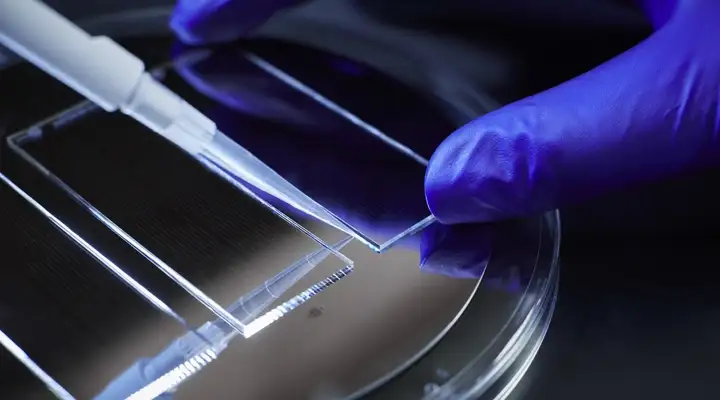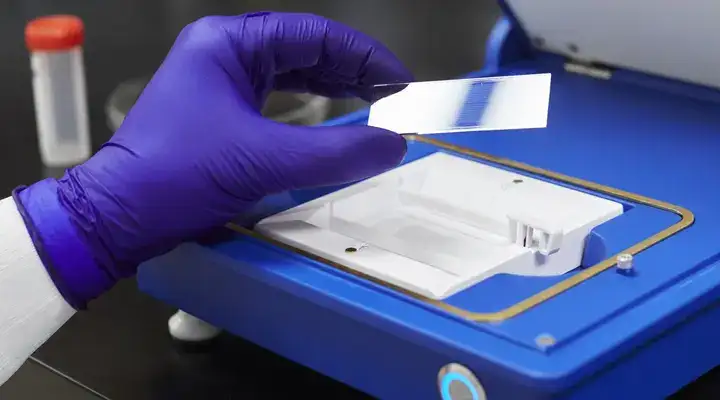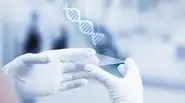
Deciphering proteins in detail
The importance of the protein expression analysis
Proteins contain the key to understanding diseases such as cancer and autoimmune conditions, as well as finding a cure for them. That’s why the analysis of protein expression in tissue plays an important role in diagnostics. “Western blotting” is an established analysis method that has been in use for 40 years.Simply put, Western blotting involves processing proteins from tissue samples through a gel matrix and sorting them by mass with the help of an electric field. The presorted proteins are transferred from the gel to a more durable membrane overnight, again using an electric field.
By later probing the membrane with antibodies that connect to specific proteins and others that react to light, a protein’s concentration, composition or binding behavior can be visualized, giving clues to the presence of a tumor, for example.
The challenges of Western blotting
“Today, Western blotting is used all over the world in almost every biological laboratory,” explains Kelly Gardner, Director of Marketing at ProteinSimple. However, one drawback is the multiple steps of preparation, probing, incubation, and washing are cumbersome for the researcher or lab personnel, while delivering only averaged results.“Western blotting only provides average protein expressions for the entire sample, which can easily consist of 100,000 cells and more,” says Gardner. “However, it supplies no answer as to whether that averaged measurement applies to individual cells and cell types within mixed samples.”
Recent research has shown that the heterogeneous profile of a sample in particular delivers fundamental information for understanding health and disease.
ProteinSimple and SCHOTT started working together in 2015 to develop a coated substrate that allows for optimal processing in protein analysis tools. From left to right: Kelly Gardner, Eric Jabart (both from ProteinSimple), and Spencer Perry (SCHOTT North America). Photo: Jens Pussel
Rethinking conventional Westerns
A few years ago, a bioengineering team at the University of California led by Professor Amy E. Herr, which Gardner was affiliated to, set out to develop the method and enable fast measurements for individual cells. The core of the concept was a glass chip with a gel layer that enables roughly 1,000 cells to be singled out and tested for different proteins in one run, and a high-performance device that processes and measures this probe in just 4-6 hours.A platform to build on
In 2013, the decision was made to form a startup, Zephyrus Biosciences, and market the concept. Two years later, the young company was acquired by Minneapolis-based Bio-Techne, a holding company for biotech enterprises, which then integrated it into ProteinSimple – the division that develops tools for protein analysis.Today, ProteinSimple markets its Single-Cell Western platform under the brand name Milo. “I always wanted a dog named Milo,” Gardner explains with a smile. “Now it stands for a new trend in the life science tools industry.”
How the Milo platform works
Every Milo kit supplies researchers with chips with a gel layer, as well as a range of buffer solutions that aid the process. Up to 6,400 tiny wells in the gel allow single cells to be captured. Varying in size depending on the chip, these microwells are barely perceptible to the eye.“When the sample suspension is applied most of them remain empty, but about 1,000 cells settle in the microwells, one per well,” says Gardner. This also means that less tissue is required to perform reliable experiments.
After the excess cells are washed off, the chip is placed in the Milo device, in which the cells are lysed and proteins are separated in-situ by electrophoresis, and immobilized in the gel by UV light. This process takes just a few minutes and eliminates the time-consuming membrane transfer step of the conventional method.
To visualize the proteins, researchers simply use the same validated antibodies as the standard Western method and read the various protein concentrations on the chip using a conventional microarray scanner. “The chips can be archived for up to nine months in case additional testing needs to be done at a later time,” says Gardner.
A precise partnership
At 75.6 x 25 mm in size and just 1 mm thick, the chips are made of a glass substrate with a razor-thin surface coating. The coating plays a key role in this scenario. It ensures that the gel remains in place so that the microwells can be formed with the utmost precision – a process ProteinSimple’s employees have constantly perfected.In the very beginning, the company used to produce the substrate itself, reports Josh Molho, Director of Engineering at ProteinSimple. However, it soon identified SCHOTT as an ideal partner.
“If, and only if, the substrate and the coating are accurate, the microwells can be accurate as well. SCHOTT worked closely with us to develop precisely the substrate we needed and gave us confidence in quality and capacity as our volume demands grew. Their longstanding experience with specialty glass and coatings was an enormous benefit for us,” he states. “As a startup, we had to act fast. We needed partners that shared this agility. Working with SCHOTT allowed us to concentrate on our actual work, the further marketing of the Milo platform.”
The advantages of collaboration
SCHOTT also sees great potential in collaborating with young companies like Zephyrus Biosciences. “The Single-Cell Western technique promises to become one of the next trends in diagnostics,” says Spencer Perry, Sales Manager at SCHOTT North America and the contact person for ProteinSimple. “Biotech startups are an essential mechanism in the transfer of scientific discovery from research to advances in the medical field. After all, enabling passionate researchers and technologies has always been part of SCHOTT’s DNA.”ProteinSimple’s development to date suggests that Perry’s assessment is correct. The Milo platform is being used in numerous governmental and private research facilities in the USA, Europe and Asia, reports Marketing Manager Gardner, primarily in cancer and stem-cell research, as well as immunology. And recently, a number of renowned professional journals have published study results obtained using Single-Cell Western analysis, including the science journal “Nature”, considered one of the world’s most respected natural science magazines.

Proteins – the building blocks of life
Proteins are found in every cell and are involved in numerous processes in our bodies: They battle infections, provide raw material for the body’s growth, and ensure that our muscles are able to help us move about. They also help transport vital substances like oxygen and iron in the blood and, as hormones, convey instructions from the brain to the rest of the body.Our DNA (deoxyribonucleic acid) contains the blueprints for protein composition, which are conveyed to the cell via RNA (ribonucleic acid). And just as DNA is the blueprint, proteins are one of the most important building blocks of life – and sometimes of death. This is because mutations can alter protein activity. Increased protein concentrations may indicate a disease. For example, an elevated concentration of the p53 protein has been found in many tumors.
Used materials & similar products
Find out more about NEXTERION® and discover our range of related products.As part of SCHOTT MINIFAB, the unique portfolio of borosilicate glass substrates known as NEXTERION® are ideal for a wide variety of DNA, protein and cell applications. Available with a range of functional coatings, from epoxysilane for peptides and antibodies to aminosilane for oligonucleotides, NEXTERION® is used for a number of diagnostic and life science applications, and is highly customizable upon request.







